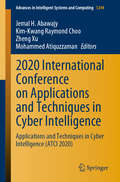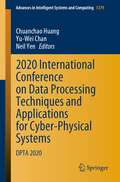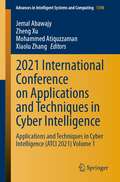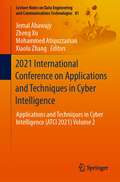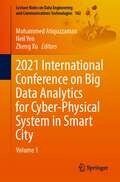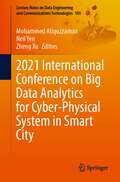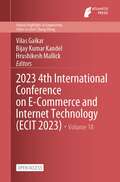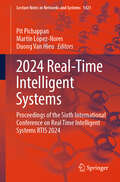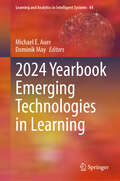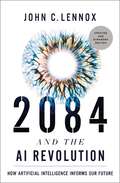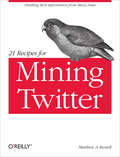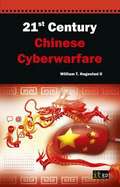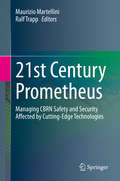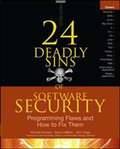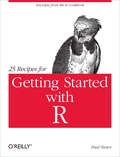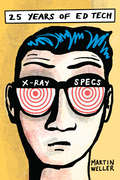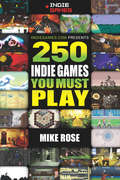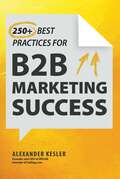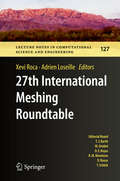- Table View
- List View
2020 International Conference on Applications and Techniques in Cyber Intelligence: Applications and Techniques in Cyber Intelligence (ATCI 2020) (Advances in Intelligent Systems and Computing #1244)
by Jemal H. Abawajy Kim-Kwang Raymond Choo Mohammed Atiquzzaman Zheng XuThis book presents innovative ideas, cutting-edge findings, and novel techniques, methods, and applications in a broad range of cybersecurity and cyberthreat intelligence areas. As our society becomes smarter, there is a corresponding need to secure our cyberfuture. The book describes approaches and findings that are of interest to business professionals and governments seeking to secure our data and underpin infrastructures, as well as to individual users.
2020 International Conference on Data Processing Techniques and Applications for Cyber-Physical Systems: DPTA 2020 (Advances in Intelligent Systems and Computing #1379)
by Neil Yen Chuanchao Huang Yu-Wei ChanThis book covers cutting-edge and advanced research on data processing techniques and applications for cyber-physical systems, gathering the proceedings of the International Conference on Data Processing Techniques and Applications for Cyber-Physical Systems (DPTA 2020), held in Laibin City, Guangxi Province, China, on December 11–12, 2020. It examines a wide range of topics, including distributed processing for sensor data in CPS networks; approximate reasoning and pattern recognition for CPS networks; data platforms for efficient integration with CPS networks; machine learning algorithms for CPS networks; and data security and privacy in CPS networks. Outlining promising future research directions, the book offers a valuable resource for students, researchers, and professionals alike, while also providing a useful reference guide for newcomers to the field.
2020 Vision: Turbocharge Your Business Today to Thrive in Tomorrow's Economy
by Stan Davis Bill DavidsonInformation management and biotechnology are reshaping the basic structure of American enterprise. In this bold and innovative analysis, Davis and Davidson explain what these changes mean and how entrepreneurs and executives can prepare challenges of tomorrow.
2021 International Conference on Applications and Techniques in Cyber Intelligence: Applications and Techniques in Cyber Intelligence (ATCI 2021) Volume 1 (Advances in Intelligent Systems and Computing #1398)
by Xiaolu Zhang Jemal Abawajy Mohammed Atiquzzaman Zheng XuThis book presents innovative ideas, cutting-edge findings, and novel techniques, methods, and applications in a broad range of cybersecurity and cyberthreat intelligence areas. As our society becomes smarter, there is a corresponding need to secure our cyberfuture. The book describes approaches and findings that are of interest to business professionals and governments seeking to secure our data and underpin infrastructures, as well as to individual users.
2021 International Conference on Applications and Techniques in Cyber Intelligence: Applications and Techniques in Cyber Intelligence (ATCI 2021) Volume 2 (Lecture Notes on Data Engineering and Communications Technologies #81)
by Xiaolu Zhang Jemal Abawajy Mohammed Atiquzzaman Zheng XuThis book presents innovative ideas, cutting-edge findings, and novel techniques, methods, and applications in a broad range of cybersecurity and cyberthreat intelligence areas. As our society becomes smarter, there is a corresponding need to secure our cyberfuture. The book describes approaches and findings that are of interest to business professionals and governments seeking to secure our data and underpin infrastructures, as well as to individual users. 1. Highlights recent applications and techniques in cyber intelligence2. Includes the proceedings of the 2021 International Conference on Applications and Techniques in Cyber Intelligence (ATCI 2021) 3. Presents a broad range of scientific research on cyber intelligence
2021 International Conference on Big Data Analytics for Cyber-Physical System in Smart City: Volume 1 (Lecture Notes on Data Engineering and Communications Technologies #102)
by Mohammed Atiquzzaman Zheng Xu Neil YenThis book gathers a selection of peer-reviewed papers presented at the third Big Data Analytics for Cyber-Physical System in Smart City (BDCPS 2021) conference, held in Shanghai, China, on Nov. 27, 2021. The contributions, prepared by an international team of scientists and engineers, cover the latest advances made in the field of machine learning, and big data analytics methods and approaches for the data-driven co-design of communication, computing, and control for smart cities. Given its scope, it offers a valuable resource for all researchers and professionals interested in big data, smart cities, and cyber-physical systems.
2021 International Conference on Big Data Analytics for Cyber-Physical System in Smart City: Volume 2 (Lecture Notes on Data Engineering and Communications Technologies #103)
by Mohammed Atiquzzaman Zheng Xu Neil YenThis book gathers a selection of peer-reviewed papers presented at the third Big Data Analytics for Cyber-Physical System in Smart City (BDCPS 2021) conference, held in Shanghai, China, on Nov. 27, 2021. The contributions, prepared by an international team of scientists and engineers, cover the latest advances made in the field of machine learning, and big data analytics methods and approaches for the data-driven co-design of communication, computing, and control for smart cities. Given its scope, it offers a valuable resource for all researchers and professionals interested in big data, smart cities, and cyber-physical systems.
2021 International Conference on Security and Information Technologies with AI, Internet Computing and Big-data Applications (Smart Innovation, Systems and Technologies #314)
by George A. Tsihrintzis Shiuh-Jeng Wang Iuon-Chang LinThis book aims to attract researchers and practitioners who are working in information technology and computer science. This edited book is about basics and high-level concepts regarding blockchain technology and application, multimedia security, information processing, security of network, cloud and IoT, cryptography and information hiding, cyber-security and evidence investigations, and learning and intelligent computing. It is becoming increasingly important to develop adaptive, intelligent computing-centric, energy-aware, secure, and privacy-aware mechanisms in high-performance computing and IoT applications. The book serves as a useful guide for industry persons and also helps beginners to learn things from basic to advance in the area of better computing paradigm. Our aim is intended to provide a platform for researchers, engineers, academicians as well as industrial professionals from all over the world to present their research results in security-related areas. We believe that this book not only presents novel and interesting ideas but also will stimulate interesting discussions from the participants and inspire new ideas.
2023 4th International Conference on E-Commerce and Internet Technology (Atlantis Highlights in Engineering #18)
by Vilas Gaikar Hrushikesh Mallick Bijay Kumar KandelThis is an open access book.E-commerce is a commercial activity centered on commodity exchange by means of information network technology. In the open network environment of the Internet, based on the client/server application method, buyers and sellers carry out various commercial activities online, realizing online shopping for consumers, online transactions between merchants and online electronic payment, as well as various business activities, trading activities, financial activities and related comprehensive service activities of a new business operation mode. It is the electronicization, networking and informatization of all aspects of traditional business activities.Internet technology is the prerequisite for e-commerce to be realized. The development and popularization of Internet technology has also played a positive role in promoting the development of e-commerce. Internet technology is a double-edged sword, with advantages and disadvantages, since it can promote the development of e-commerce, it may also affect its normal construction, such as the existence of theft of information, tampering with information, counterfeiting, malicious damage and other security risks, but also through the firewall technology, data encryption technology, authentication technology, digital signature technology and other technologies to regulate the transaction process.Therefore, the influence of the two is mutual, and only through continuous friction can we continuously promote the development of both sides in a benign direction.ECIT 2023 provides a platform in order toCreate a forum for sharing, research and exchange at the international level, so that participants can be informed of the latest research directions, results and contents of applied Internet technologies on e-commerce, thus stimulating them to generate new research ideas.Promote the development of e-commerce by studying its problems.To open up new perspectives, broaden horizons and examine the issues under discussion by the participants.Each accepted article requires at least one author to attend the meeting and present it.
2024 Real-Time Intelligent Systems: Proceedings of the Sixth International Conference on Real Time Intelligent Systems RTIS 2024 (Lecture Notes in Networks and Systems #1421)
by Pit Pichappan Martín López-Nores Duong Van HieuIn the rapidly advancing field of Intelligent Computing, tracking, monitoring, synthesizing, and inferencing real-time data is becoming a crucial field of interest. This will impact several research themes, including all sub-domains of AI. The significance of real-time data processing lies in their ability to produce remarkably realistic implications, thereby mitigating challenges associated with intelligence capturing. This compendium reflects the recent progress in real-time intelligence, sensing the innovative approaches and addressing the challenges. It includes both core research and various applications in various disciplines. This publication enables young researchers and master&’s students to understand the requirements for initiating research in real-time computing.
2024 Yearbook Emerging Technologies in Learning (Learning and Analytics in Intelligent Systems #44)
by Michael E. Auer Dominik MayThis book brings together global scholars to examine critical developments in education, from the integration of artificial intelligence (AI) in various educational contexts to the evolving relationship between on-campus, remote, and hybrid learning and the rise of digitally native learners. As educational paradigms shift rapidly in response to globalization, digitization, and technological advances, this book provides a timely exploration of the future of higher education. Organized into three sections, the book delves into: Generative AI in Higher Education—Unpacking the transformative potential and challenges of AI tools in teaching and learning. Remote, Virtual, and Hybrid Teaching in Higher Education—Exploring innovative teaching modalities that redefine classroom boundaries. Educational Research and Emerging Pedagogical Trends in Higher Education—Highlighting cutting-edge research that addresses the evolving demands of modern learners. For educators, researchers, and EdTech professionals, this yearbook serves as an essential resource to stay ahead in the ever-evolving landscape of technology-enhanced learning.
2030 - Strategieentwicklung für Innovation Leaders: Mit Handlungsanweisungen unter Einbezug neuester Methoden der Datennutzung
by Tobias Hertfelder Philipp FutterknechtSeit der Relativitätstheorie wissen wir, dass massereiche Objekte durch ihre Gravitation Dinge anziehen. Je größer die Masse desto größer ist auch die Anziehungskraft. Genauso verhält es sich auch in Strategieprojekten. Jeder Projektteilnehmer ist dabei ein massereicher Teilnehmer und hat Auswirkungen auf das Zusammenspiel. Was sich gravierend geändert hat ist der Einfluss der Daten auf diesen Prozess. Wer dies nicht berücksichtigt, wird in Zukunft enorme Einbußen hinnehmen müssen. Da sich durch diese Veränderung ein neues Gleichgewicht einstellt, ändern sich auch die Erfolgsaussichten der angewandten Methoden und Verhaltensweisen. Wie Sie diesen Wandel meistern können und was Sie dazu benötigen erfahren Sie in diesem Buch.
2084 and the AI Revolution, Updated and Expanded Edition: How Artificial Intelligence Informs Our Future
by John C. LennoxWill technology change what it means to be human?You don't have to be a computer scientist to have discerning conversations about artificial intelligence and technology. We all wonder where we're headed. Even now, technological innovations and machine learning have a daily impact on our lives, and many of us see good reasons to dread the future. Are we doomed to the surveillance society imagined in George Orwell's 1984?Mathematician and philosopher John Lennox believes that there are credible responses to the daunting questions that AI poses, and he shows that Christianity has some very serious, sensible, evidence-based things to say about the nature of our quest for superintelligence.This newly updated and expanded edition of 2084 will introduce you to a kaleidoscope of ideas:Key recent developments in technological enhancement, bioengineering, and, in particular, artificial intelligence.Consideration of the nature of AI systems with insights from neuroscience.The way AI is changing how we communicate, implications for medicine, manufacturing and the military, its use in advertising and automobiles, and education and the future of work.How data is used today for surveillance, thought control.The rise of virtual reality and the metaverse.The transhumanist agenda and longtermism.The agreements and disagreements that scientists and experts have about the future of AI.The urgent need for regulation and control in light of the development of large language transformers like CHATGPT.Key insights from Scripture about the nature of human beings, the soul, our moral sense, our future, and what separates us from machines. In straight-forward, accessible language, you will get a better understanding of the current capacity of AI, its potential benefits and dangers, the facts and the fiction, as well as possible future implications.Since the questions posed by AI, daunting as they might be, affect most of us, they demand answers. 2084 and the AI Revolution, Updated and Expanded Edition has been written to challenge and ignite the curiosity of all readers. Whatever your worldview, Lennox provides clear information and credible answers that will bring you real hope for the future of humanity.
21 Recipes for Mining Twitter: Distilling Rich Information from Messy Data
by Matthew A. RussellMillions of public Twitter streams harbor a wealth of data, and once you mine them, you can gain some valuable insights. This short and concise book offers a collection of recipes to help you extract nuggets of Twitter information using easy-to-learn Python tools. Each recipe offers a discussion of how and why the solution works, so you can quickly adapt it to fit your particular needs. The recipes include techniques to:Use OAuth to access Twitter dataCreate and analyze graphs of retweet relationshipsUse the streaming API to harvest tweets in realtimeHarvest and analyze friends and followersDiscover friendship cliquesSummarize webpages from short URLsThis book is a perfect companion to O’Reilly's Mining the Social Web.
21st Century C
by Ben KlemensThrow out your old ideas of C, and relearn a programming language that's substantially outgrown its origins. With 21st Century C, you'll discover up-to-date techniques that are absent from every other C text available. C isn't just the foundation of modern programming languages, it is a modern language, ideal for writing efficient, state-of-the-art applications. Learn to dump old habits that made sense on mainframes, and pick up the tools you need to use this evolved and aggressively simple language. No matter what programming language you currently champion, you'll agree that C rocks. Set up a C programming environment with shell facilities, makefiles, text editors, debuggers, and memory checkers Use Autotools, C's de facto cross-platform package manager Learn which older C concepts should be downplayed or deprecated Explore problematic C concepts that are too useful to throw out Solve C's string-building problems with C-standard and POSIX-standard functions Use modern syntactic features for functions that take structured inputs Build high-level object-based libraries and programs Apply existing C libraries for doing advanced math, talking to Internet servers, and running databases
21st Century C: C Tips from the New School
by Ben KlemensThrow out your old ideas about C and get to know a programming language that’s substantially outgrown its origins. With this revised edition of 21st Century C, you’ll discover up-to-date techniques missing from other C tutorials, whether you’re new to the language or just getting reacquainted.C isn’t just the foundation of modern programming languages; it is a modern language, ideal for writing efficient, state-of-the-art applications. Get past idioms that made sense on mainframes and learn the tools you need to work with this evolved and aggressively simple language. No matter what programming language you currently favor, you’ll quickly see that 21st century C rocks.Set up a C programming environment with shell facilities, makefiles, text editors, debuggers, and memory checkersUse Autotools, C’s de facto cross-platform package managerLearn about the problematic C concepts too useful to discardSolve C’s string-building problems with C-standard functionsUse modern syntactic features for functions that take structured inputsBuild high-level, object-based libraries and programsPerform advanced math, talk to internet servers, and run databases with existing C librariesThis edition also includes new material on concurrent threads, virtual tables, C99 numeric types, and other features.
21st Century Chinese Cyberwarfare
by William T. Hagestad II21st Century Chinese Cyberwarfare draws from a combination of business, cultural, historical, linguistic and the author s personal experience to attempt to explain China to the uninitiated. The objective of the book is to raise awareness of the fact that the People's Republic of China is using a combination of their unique culture, language, and political will, known as Chinese Communism, to maintain their cultural heritage. This book is the first to gather the salient information regarding the use of cyber warfare doctrine by the People's Republic of China to promote its own hegemonistic, national self-interests and enforce its political, military and economic will on other nation states. The threat of Chinese Cyberwarfare can no longer be ignored. It is a clear and present danger to the experienced and innocent alike and will be economically, societally and culturally changing and damaging for the nations that are targeted.
21st Century Prometheus: Managing CBRN Safety and Security Affected by Cutting-Edge Technologies
by Maurizio Martellini Ralf TrappThis book describes the evolving CBRN risk landscape and highlights advances in the “core” CBRN technologies, including when combined with (improvised) explosive devices (CBRNe threats). It analyses how associated technologies create new safety and security risks, challenging certain assumptions that underlie current control regimes. The book also shows how technologies can be enablers for more effective strategies to mitigate these risks.21st-century safety and security risks emanating from chemical, biological, radiological and nuclear materials – whether resulting from natural events, accidents or malevolent use - are increasingly shaped by technologies that enable their development, production or use in ways that differ from the past. Artificial intelligence, the use of cyberspace, the revolution in the life sciences, new manufacturing methods, new platforms and equipment for agent delivery, hypersonic weapons systems, information tools utilised in hybrid warfare – these and other technologies are reshaping the global security environment and CBRN landscape. They are leading to a growing potential for highly targeted violence, and they can lead to greater instability and vulnerability worldwide. At the same time, technology offers solutions to manage CBRN risks. Examples are faster detection, more accurate characterisation of the nature and origin of CBRN agents, new forensic investigation methods, or new medical treatments for victims of CBRN incidents. New educational concepts help to foster a culture of responsibility in science and technology and strengthen governance. New training methods help develop practical skills to manage CBRN risks more effectively.The book concludes that there is a growing need for a holistic framework towards CBRN risk mitigation. Traditional arms control mechanisms such as global, regional or bilateral treaties and export controls are still needed, as they provide a necessary legal and institutional framework. But laws and technology denial alone will not suffice, and institutional mechanisms can at times be weak. Given the pace of technological progress and the diffusion of critical knowledge, tools and materials, policymakers must accept that CBRN risks cannot be eliminated altogether. Instead, society has to learn to manage these risks and develop resilience against them. This requires a “softer”, broadly based multi-stakeholder approach involving governments, industry, the research and development communities, educators, and civil society. Furthermore, educating policymakers that cutting-edge technologies may seriously affect global strategic stability could create incentives for developing a more creative and contemporary arms control strategy that fosters cooperation rather than incremental polarisation.
24 Deadly Sins Of Software Security: Programming Flaws And How To Fix Them
by John Viega Michael Howard David LeBlancFully updated to cover the latest security issues, 24 Deadly Sins of Software Security reveals the most common design and coding errors and explains how to fix each one-or better yet, avoid them from the start. Michael Howard and David LeBlanc, who teach Microsoft employees and the world how to secure code, have partnered again with John Viega, who uncovered the original 19 deadly programming sins. They have completely revised the book to address the most recent vulnerabilities and have added five brand-new sins. This practical guide covers all platforms, languages, and types of applications. Eliminate these security flaws from your code:
24/7 Politics: Cable Television and the Fragmenting of America from Watergate to Fox News (Politics and Society in Modern America #148)
by Kathryn Cramer BrownellHow cable television upended American political life in the pursuit of profits and influenceAs television began to overtake the political landscape in the 1960s, network broadcast companies, bolstered by powerful lobbying interests, dominated screens across the nation. Yet over the next three decades, the expansion of a different technology, cable, changed all of this. 24/7 Politics tells the story of how the cable industry worked with political leaders to create an entirely new approach to television, one that tethered politics to profits and divided and distracted Americans by feeding their appetite for entertainment—frequently at the expense of fostering responsible citizenship.In this timely and provocative book, Kathryn Cramer Brownell argues that cable television itself is not to blame for today&’s rampant polarization and scandal politics—the intentional restructuring of television as a political institution is. She describes how cable innovations—from C-SPAN coverage of congressional debates in the 1980s to MTV&’s foray into presidential politics in the 1990s—took on network broadcasting using market forces, giving rise to a more decentralized media world. Brownell shows how cable became an unstoppable medium for political communication that prioritized cult followings and loyalty to individual brands, fundamentally reshaped party politics, and, in the process, sowed the seeds of democratic upheaval.24/7 Politics reveals how cable TV created new possibilities for antiestablishment voices and opened a pathway to political prominence for seemingly unlikely figures like Donald Trump by playing to narrow audiences and cultivating division instead of common ground.
25 Recipes for Getting Started with R: Excerpts from the R Cookbook
by Paul TeetorR is a powerful tool for statistics and graphics, but getting started with this language can be frustrating. This short, concise book provides beginners with a selection of how-to recipes to solve simple problems with R. Each solution gives you just what you need to know to use R for basic statistics, graphics, and regression.You'll find recipes on reading data files, creating data frames, computing basic statistics, testing means and correlations, creating a scatter plot, performing simple linear regression, and many more. These solutions were selected from O'Reilly's R Cookbook, which contains more than 200 recipes for R that you'll find useful once you move beyond the basics.
25 Years of Ed Tech (Issues in Distance Education)
by Martin WellerIn this lively and approachable volume based on his popular blog series, Martin Weller demonstrates a rich history of innovation and effective implementation of ed tech across higher education. From Bulletin Board Systems to blockchain, Weller follows the trajectory of education by focusing each chapter on a technology, theory, or concept that has influenced each year since 1994. Calling for both caution and enthusiasm, Weller advocates for a critical and research-based approach to new technologies, particularly in light of disinformation, the impact of social media on politics, and data surveillance trends. A concise and necessary retrospective, this book will be valuable to educators, ed tech practitioners, and higher education administrators, as well as students.
250 Indie Games You Must Play
by Mike RoseThis book is a guide to the expanding world of indie gaming. It helps readers to understand why indie games are so important to so many people in the entertainment industry. The book covers puzzlers, platformers, beat 'em ups, shoot 'em ups, role-playing, and strategy.
250+ Best Practices for B2B Marketing Success
by Alexander KeslerMASTER B2B MARKETING WITH AN EXTENSIVE HOW-TO GUIDE PACKED WITH OVER 250 VALUABLE STRATEGIES250+ Best Practices for B2B Marketing Success is a step-by-step guide to becoming a leading B2B marketing professional. Written by Alexander Kesler, a seasoned marketing practitioner and thought leader, this book serves as a resource for every level of B2B professional, from those taking their first steps into the B2B marketing world to the most experienced pundits.250+ Best Practices for B2B Marketing Success synthesizes best practices that can take years to learn into an easy-to-understand (and easy-to-implement) guide. The information in this book is proven, ready-to-use, and contains steps that most marketers can apply right away—on everything from crafting content to measuring its effectiveness at the campaign&’s end. Above all, this book presents engaging strategies and practices suitable for any business. Short and to the point, marketers can apply the advice presented here at any point in their career, from college to the boardroom. If you are a digital marketing or business leader who grapples with the problems and challenges of today&’s multi-faceted and ever-evolving industry, 250+ Best Practices for B2B Marketing Success will help you implement proven strategies into your own B2B marketing initiatives with accomplished ease.
27th International Meshing Roundtable (Lecture Notes in Computational Science and Engineering #127)
by Adrien Loseille Xevi RocaThe International Meshing Roundtable (IMR) brings together researchers, developers, and application experts in a variety of disciplines, from all over the world, to present and discuss ideas on mesh generation and related topics. The technical papers in this volume present theoretical and novel ideas and algorithms with practical potential, as well as technical applications in science and engineering, geometric modelling, computer graphics, and visualization.
